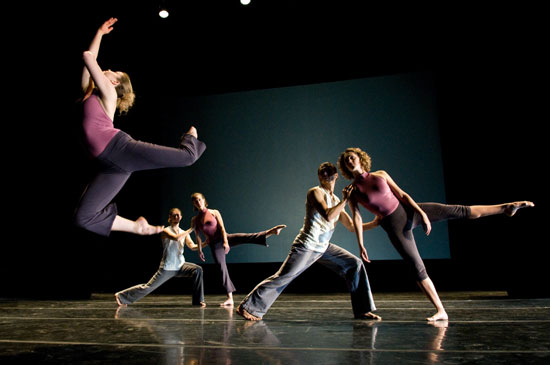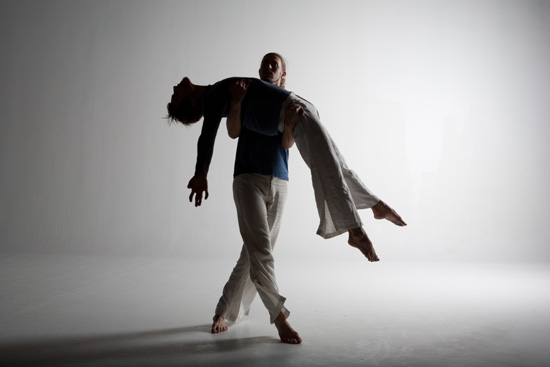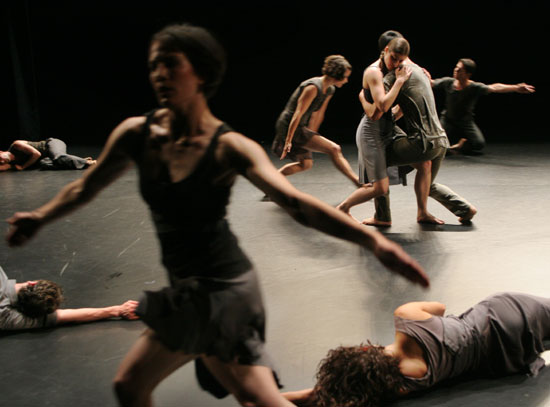|
Given her many talents, vast interests and deep intelligence Hope Mohr has never lacked options. She trained as a ballet dancer early in life, explored modern dance while attending Stanford University, then attempted to abandon dance to give the law a try. While receiving numerous awards and fellowships in law school at Columbia she couldn't resist the pull of modern dance and found herself dividing her time between the rigors of dancing professionally and the no-less competitive world of legal studies. After studying on scholarship at both the Merce Cunningham Studio and Trisha Brown Studio, she joined Brown's company and toured the world. Never completely departing from her legal background, her interest in and commitment to social justice have always fueled her work.
She founded Hope Mohr Dance in San Francisco in 2007 though she has been creating original work since 1994. Her inspiration springs from concerns about the environment, her deep compassion for human suffering and the many ways we struggle to find and express intimacy. Last year's "The Unsayable" grew out of an in-depth collaboration with military veterans who attended rehearsals and performed on stage with the dancers. Her work with veterans did not stop with the premiere of the work and is ongoing.
As an expression of her expansive vision and desire to constantly explore creative connections, she has also become a curator in San Francisco by presenting her annual season as a shared program of "call and response" with an East Coast-based artist. This year Hope Mohr Dance presented its annual season at Z Space in San Francisco with Dušan Týnek Dance Theatre of New York City.
Founded by the Czech-born Týnek, who worked closely for many years with his mentor Merce Cunningham, this small company earns wide praise. Týnek and Mohr met while both dancing on scholarship at the Cunningham Studio and performing with Lucinda Childs for her company's 25th anniversary. While both choreographers use dancers whose backgrounds include similarly rigorous technical training they are both also attracted to dancers who are capable of nuanced expression to communicate with the audience.
 |
For the world premiere of "Reluctant Light," Hope Mohr commissioned a set composed of cubes constructed in PVC pipe in various sized squares and rectangles. The piece opens with Cameron Growden diving right through one of the rectangular boxes lying downstage near the audience. This kind of athletic daring and playful exploration of line and form continue throughout the beautifully constructed work. All seven dancers (the others are Derek Harris, Katharine Hawthorne, Roche Janken, Justin Morrison and Tegan Schwab) display their strong dance technique while never betraying their connection to each other and their relationship to the set. The boxes serve all imaginable purposes as Mohr explores ideas of emotional and physical surrender but they never become distracting or tedious.
Mohr's original inspiration for the piece came to her while visiting a museum. She wished to explore the intersection between drawing and dancers, to explore the ways that lines in space and lines created by dancers' bodies could act upon each other. Another inspiration was the Buddhist heart mantra: "Form is empty. Emptiness is form."
Adding to the visual splendor of the piece, cellist Helen Money performed her original rock compositions in an upstage corner as close-up black and white images of string instruments seemed to float in the darkness upstage. Costumes consisting of deep purple pants and ivory tunics designed by Jamielynn for Eimaj Design were perfectly conceived to move with the dancers throughout their athletic and technical feats.
 |
As the work progressed, the dancers' explorations and interactions with each other and the boxes built dramatic and physical momentum. Duets entered into emotionally-charged and physically explosive expressions of anger, violence and tenderness. Tegan Schwab threw herself against Cameron Growden over and over again. Katharine Hawthorne and Justin Morrison engaged in a battle of wills while always remaining contained within a large horizontal rectangle. It ended in an almost humorous expression of how it feels to fight with someone but to remain together, by either choice or circumstance, silent and frustrated, in a small space that must contain all the physical and emotional weight of the confrontation. Mohr expertly contrasts common pedestrian movement and gestures against precise and formal choreography so that neither form overtakes the other. The dancers communicate with each other and with the audience in ways that look and feel spontaneous, never contrived.
In a rare solo performance, Mohr performed a solo entitled "Plainsong" in which she remained nested, until the very end, in a large square space defined by configurations of bright red yarn (the evocative set was created by Katrina Rodabaugh). Inspired by Penelope as she waited for Odysseus, endlessly weaving, or pretending to weave, or avoiding weaving her burial shroud, Mohr expresses various states of loneliness, frustration, open-eyed awe and wonder, and finally the capacity to use her cleverness and intelligence to escape her emotional and physical captivity.
Mohr's choreographic vocabulary is grounded in the clean lines and slicing precision of Cunningham but speaks clearly of her own explorations with the body and the ideas she longs and labors to express. Balancing sparse passages with phrases of full physicality, her choreography is always detailed and intentional. As a performer, she embodies the presence of someone who is unafraid to confront stillness and silence but instead opens herself to the possibilities she finds in her boundless imagination.
 |
Dušan Týnek and Mohr shared the common experience of years of training at the Cunningham Studio and their devotion to this demanding and detailed technique is clear in both their work. In the two works Týnek presented at Z Space in San Francisco, "Transparent Walls" and "Base Pairs," he adhered in form and content to a more traditional choreographic vision. "Base Pairs," set to a text by Cynthia Polutanovich read with warmth and Laurie Anderson-like expression by Lucinda Childs, is the more formal of the two. Though the text speaks of "longing for each other" and "what did days mean before you?" there is little warmth or intimacy on stage. The eight dancers perform their straight arm gestures and shifting body facings accompanied by the clicking of a metronome yet even when the choreography joins them in partnership there is no change in their affect, only the juxtaposition of the robotic movement and pulsing sound against the poetry.
"Transparent Walls" is a much warmer and expressive piece made even more interesting by the use of a long horizontal line of bright white lights, broken into three equal lengths, that illuminates the stage closest to the audience while obscuring the area upstage. The effect creates the brilliant visual illusion that the dancers appear and disappear while still moving. Duos continuously come and go leaving the feeling that the dance continues elsewhere in the dark night. All eight dancers, Alexandra Berger, Ann Chiaverini, John Eirich, Emily Gayeski, Elisa Osborne, Samuel Swanton, Satoshi Takao and Nicholas Wagner dance with great technical mastery and an inspired sense of ensemble.
(Please note that Hope Mohr will appear in "the tools of unmaking," choreographers and visual artists on the practice of presence, at Shotwell Studios in San Francisco on Friday, April 27 and Saturday, April 28.)
Photos by Margo Moritz, Austin Ford and Julie Lemberger
|



